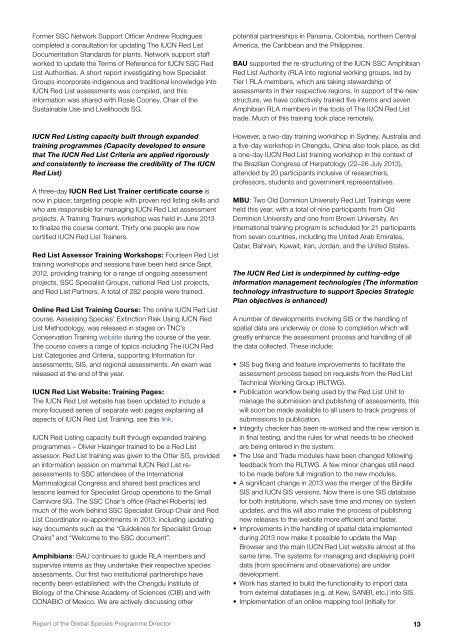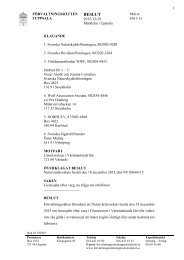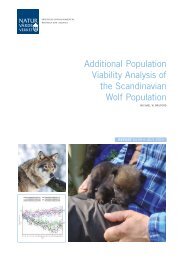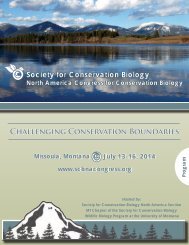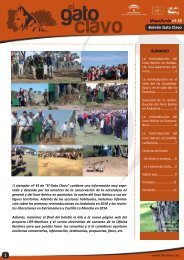1oC3Dbk
1oC3Dbk
1oC3Dbk
You also want an ePaper? Increase the reach of your titles
YUMPU automatically turns print PDFs into web optimized ePapers that Google loves.
Former SSC Network Support Officer Andrew Rodrigues<br />
completed a consultation for updating The IUCN Red List<br />
Documentation Standards for plants. Network support staff<br />
worked to update the Terms of Reference for IUCN SSC Red<br />
List Authorities. A short report investigating how Specialist<br />
Groups incorporate indigenous and traditional knowledge into<br />
IUCN Red List assessments was compiled, and this<br />
information was shared with Rosie Cooney, Chair of the<br />
Sustainable Use and Livelihoods SG.<br />
IUCN Red Listing capacity built through expanded<br />
training programmes (Capacity developed to ensure<br />
that The IUCN Red List Criteria are applied rigorously<br />
and consistently to increase the credibility of The IUCN<br />
Red List)<br />
A three-day IUCN Red List Trainer certificate course is<br />
now in place; targeting people with proven red listing skills and<br />
who are responsible for managing IUCN Red List assessment<br />
projects. A Training Trainers workshop was held in June 2013<br />
to finalize the course content. Thirty one people are now<br />
certified IUCN Red List Trainers.<br />
Red List Assessor Training Workshops: Fourteen Red List<br />
training workshops and sessions have been held since Sept.<br />
2012, providing training for a range of ongoing assessment<br />
projects, SSC Specialist Groups, national Red List projects,<br />
and Red List Partners. A total of 282 people were trained.<br />
Online Red List Training Course: The online IUCN Red List<br />
course, Assessing Species’ Extinction Risk Using IUCN Red<br />
List Methodology, was released in stages on TNC’s<br />
Conservation Training website during the course of the year.<br />
The course covers a range of topics including The IUCN Red<br />
List Categories and Criteria, supporting Information for<br />
assessments, SIS, and regional assessments. An exam was<br />
released at the end of the year.<br />
IUCN Red List Website: Training Pages:<br />
The IUCN Red List website has been updated to include a<br />
more focused series of separate web pages explaining all<br />
aspects of IUCN Red List Training, see this link.<br />
IUCN Red Listing capacity built through expanded training<br />
programmes – Olivier Hasinger trained to be a Red List<br />
assessor. Red List training was given to the Otter SG, provided<br />
an information session on mammal IUCN Red List reassessments<br />
to SSC attendees of the International<br />
Mammalogical Congress and shared best practices and<br />
lessons learned for Specialist Group operations to the Small<br />
Carnivore SG. The SSC Chair’s office (Rachel Roberts) led<br />
much of the work behind SSC Specialist Group Chair and Red<br />
List Coordinator re-appointments in 2013; including updating<br />
key documents such as the “Guidelines for Specialist Group<br />
Chairs” and “Welcome to the SSC document”.<br />
Amphibians: BAU continues to guide RLA members and<br />
supervise interns as they undertake their respective species<br />
assessments. Our first two institutional partnerships have<br />
recently been established: with the Chengdu Institute of<br />
Biology of the Chinese Academy of Sciences (CIB) and with<br />
CONABIO of Mexico. We are actively discussing other<br />
potential partnerships in Panama, Colombia, northern Central<br />
America, the Caribbean and the Philippines.<br />
BAU supported the re-structuring of the IUCN SSC Amphibian<br />
Red List Authority (RLA into regional working groups, led by<br />
Tier I RLA members, which are taking stewardship of<br />
assessments in their respective regions. In support of the new<br />
structure, we have collectively trained five interns and seven<br />
Amphibian RLA members in the tools of The IUCN Red List<br />
trade. Much of this training took place remotely.<br />
However, a two-day training workshop in Sydney, Australia and<br />
a five-day workshop in Chengdu, China also took place, as did<br />
a one-day IUCN Red List training workshop in the context of<br />
the Brazilian Congress of Herpetology (22–26 July 2013),<br />
attended by 20 participants inclusive of researchers,<br />
professors, students and government representatives.<br />
MBU: Two Old Dominion University Red List Trainings were<br />
held this year, with a total of nine participants from Old<br />
Dominion University and one from Brown University. An<br />
international training program is scheduled for 21 participants<br />
from seven countries, including the United Arab Emirates,<br />
Qatar, Bahrain, Kuwait, Iran, Jordan, and the United States.<br />
The IUCN Red List is underpinned by cutting-edge<br />
information management technologies (The information<br />
technology infrastructure to support Species Strategic<br />
Plan objectives is enhanced)<br />
A number of developments involving SIS or the handling of<br />
spatial data are underway or close to completion which will<br />
greatly enhance the assessment process and handling of all<br />
the data collected. These include:<br />
• SIS bug fixing and feature improvements to facilitate the<br />
assessment process based on requests from the Red List<br />
Technical Working Group (RLTWG).<br />
• Publication workflow being used by the Red List Unit to<br />
manage the submission and publishing of assessments, this<br />
will soon be made available to all users to track progress of<br />
submissions to publication.<br />
• Integrity checker has been re-worked and the new version is<br />
in final testing, and the rules for what needs to be checked<br />
are being entered in the system.<br />
• The Use and Trade modules have been changed following<br />
feedback from the RLTWG. A few minor changes still need<br />
to be made before full migration to the new modules.<br />
• A significant change in 2013 was the merger of the Birdlife<br />
SIS and IUCN SIS versions. Now there is one SIS database<br />
for both institutions, which save time and money on system<br />
updates, and this will also make the process of publishing<br />
new releases to the website more efficient and faster.<br />
• Improvements in the handling of spatial data implemented<br />
during 2013 now make it possible to update the Map<br />
Browser and the main IUCN Red List website almost at the<br />
same time. The systems for managing and displaying point<br />
data (from specimens and observations) are under<br />
development.<br />
• Work has started to build the functionality to import data<br />
from external databases (e.g. at Kew, SANBI, etc.) into SIS.<br />
• Implementation of an online mapping tool (initially for<br />
Report of the Global Species Programme Director<br />
13


